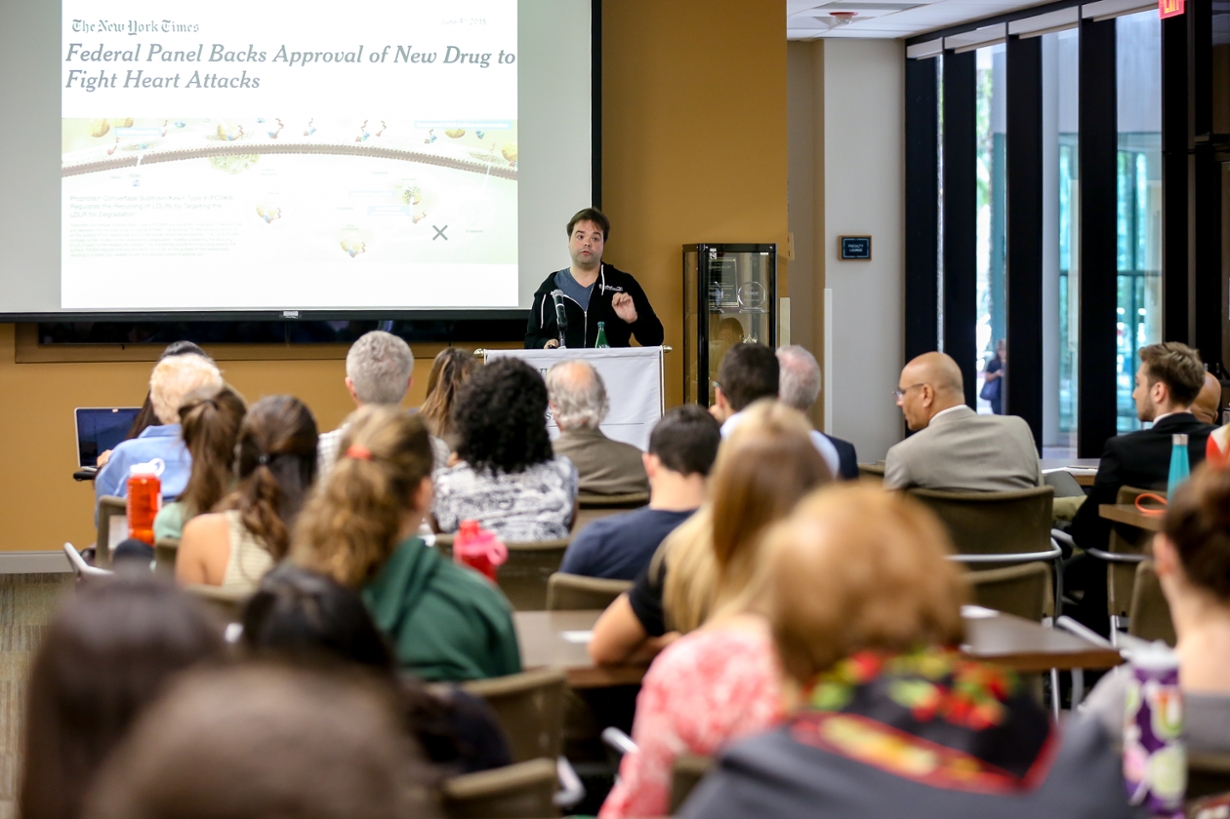That’s part of a vision presented by the University’s presidential scholar, Carlos Bustamante, during an April 17 colloquium hosted by the School’s Center for Health Sector Management and Policy. Bustamante, a Harvard graduate, is a professor of genetics and biomedical data science at Stanford University. He also advises the U.S. government, private companies, non-profits and startups on programs that combine health and tech.
Bustamante sees an opportunity to develop “a digital-tech health safety net,” mobilizing genetics and Big Data, in order to provide faster, better and cheaper care in the United States and beyond. He made the case in a data-rich presentation, while dressed in a T-shirt and hooded sweatshirt, Silicon-Valley style.
“It’s going to be guys and gals in hoodies who are going to spur the revolution in health care,” Bustamante told an audience of students, faculty members and administrators.
With the United States spending more per person on health care than any nation but ranked roughly No. 40 in health outcomes, there’s certainly a need to slash U.S. costs. Those high costs stem partly from a century-old system based on treating health problems, not preventing or predicting them, he said.
But breakthroughs in genetics, such as DNA tests, can help predict problems and target them. For example, women in the U.S. have a roughly 16 percent chance of getting breast cancer. But those found to have a certain gene have an 80 percent chance and could be better monitored or treated, helping avert high costs for cancer later, he said. Tests for genes are no longer expensive, said Bustamante.
Yet the way data is handled in the U.S. health care system complicates the issue. Americans now commonly fill out similar paper forms for different doctors who may not share that information with each other or the patient – while as consumers, they let Amazon.com know their tastes and suggest products. Wouldn’t aggregating health data, with patient consent, help identify medical patterns, boost outcomes and cut costs?, Bustamante asked.
Some startups in Silicon Valley already are mobilizing patient data to improve health outcomes. Using Facebook Messenger, six people in a strip mall last year got about half-million people in Brazil to answer medical questions during the Zika virus outbreak. The answers helped predict that 15,000 were at high-risk for Zika, he said. “They can begin to get this data at scale. That’s the exciting part,” he said.
The U.S. health insurance system further aggravates the problem by keeping lots of data in silos. Unlike single paper systems elsewhere, U.S. patients pay different prices based on the type of insurance they have or don’t have. Doctors often have no clue about the cost of tests they order. Administrators with data often won’t share it, citing regulatory reasons. One upshot: high insurance costs, especially for the self-employed, at a time when more people are moving into the gig economy, said Bustamante.
But what if patients opted to share their own data? Bustamante noted that millions already have done DNA tests through sites like Ancestry.com. He suggested that those people with a propensity for certain diseases could opt for regular tests and for wearable technology such as bracelets to monitor themselves regularly and remotely.
Those answers matter. Health care now accounts for nearly 20 percent of U.S. spending, up from 5 percent a half-century ago, Bustamante said, representing “the No. 1 drag on the U.S. economy.”

